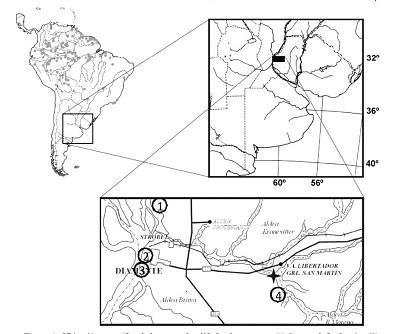Ana María Walther and Mabel Mena
2 013
Latinmag Letters, Volume 3, Special Issue (2013), PB17, 1-5. Proceedings Montevideo, Uruguay
Se presenta un estudio paleomagnético preliminar realizado en las formaciones La Juanita y Punta Gorda,
del Grupo Punta Gorda y la Formación Salto Ander Egg. Estas unidades sedimentarias están expuestas en la Provincia de Entre Ríos. Las direcciones de remanencia magnéticas encontradas permitieron asignar edades magnéticas que llevaron a las siguientes interpretaciones: 1) considerar una edad Matuyama para el Grupo Punta Gorda, con la Fm. La Juanita ubicada en el techo del Sanandresense mientras la Fm. Punta Gorda se habría depositado durante el evento normal Olduvai. 2) La Fm. La Juanita tendría un edad más joven (≤ 1.77 Ma) dentro del cron Matuyama y la Fm. Punta Gorda podría corresponder con el evento normal Jaramillo o alternativamente a la base del cron Bruhnes. La primera opción sugiere que el Grupo Punta Gorda se depositó en un ciclo de sedimentación continua durante el Pleistoceno temprano (2.5-1.77 Ma). Las otras opciones sugieren una secuencia sedimentaria muy extendida temporalmente, desde 2.5 Ma hasta la base del Pleistoceno medio (≤ 0.78 Ma), con unidades separadas por discontinuidades representativas de lapsos significativos. La polaridad normal y la edad Pleistoceno tardío previamente asignada sugieren una edad magnética Bruhnes < 0.78 Ma para la Fm. Salto Ander Egg.
del Grupo Punta Gorda y la Formación Salto Ander Egg. Estas unidades sedimentarias están expuestas en la Provincia de Entre Ríos. Las direcciones de remanencia magnéticas encontradas permitieron asignar edades magnéticas que llevaron a las siguientes interpretaciones: 1) considerar una edad Matuyama para el Grupo Punta Gorda, con la Fm. La Juanita ubicada en el techo del Sanandresense mientras la Fm. Punta Gorda se habría depositado durante el evento normal Olduvai. 2) La Fm. La Juanita tendría un edad más joven (≤ 1.77 Ma) dentro del cron Matuyama y la Fm. Punta Gorda podría corresponder con el evento normal Jaramillo o alternativamente a la base del cron Bruhnes. La primera opción sugiere que el Grupo Punta Gorda se depositó en un ciclo de sedimentación continua durante el Pleistoceno temprano (2.5-1.77 Ma). Las otras opciones sugieren una secuencia sedimentaria muy extendida temporalmente, desde 2.5 Ma hasta la base del Pleistoceno medio (≤ 0.78 Ma), con unidades separadas por discontinuidades representativas de lapsos significativos. La polaridad normal y la edad Pleistoceno tardío previamente asignada sugieren una edad magnética Bruhnes < 0.78 Ma para la Fm. Salto Ander Egg.
We present a preliminary paleomagnetic study performed on three late Cenozoic continental sedimentary
units, exposed at Entre Ríos province: La Juanita and Punta Gorda formations, belonging to the Punta Gorda Group, and the Salto Ander Egg Formation. The magnetic remanence directions allowed to assign magnetic ages that lead to the following interpretations: 1) Consider a Matuyama age for the Punta Gorda group, then La Juanita Fm. would correspond at the top of Sanandresian while the Punta Gorda Fm. may have been deposited during the Olduvai normal event. 2) La Juanita Fm. was deposited during the Matuyama chron but with a younger age (≤ 1.77 Ma). The Punta Gorda Fm. may correspond to the Jaramillo normal event or alternatively to the bottom of Bruhnes chron. The first option suggests that Punta Gorda Group was deposited in a cycle of continuous sedimentation during the Early Pleistocene, (2.5-1.77 Ma). The other options suggest a time-extended sedimentary sequence from 2.5 Ma to the bottom of the Middle Pleistocene (≤ 0.78 Ma), with units separated by unconformities that represent significant periods of time. A normal polarity and the previously assigned age of upper Pleistocene suggest a Bruhnes magnetic age < 0.78 Ma for Salto Ander Egg Fm.
units, exposed at Entre Ríos province: La Juanita and Punta Gorda formations, belonging to the Punta Gorda Group, and the Salto Ander Egg Formation. The magnetic remanence directions allowed to assign magnetic ages that lead to the following interpretations: 1) Consider a Matuyama age for the Punta Gorda group, then La Juanita Fm. would correspond at the top of Sanandresian while the Punta Gorda Fm. may have been deposited during the Olduvai normal event. 2) La Juanita Fm. was deposited during the Matuyama chron but with a younger age (≤ 1.77 Ma). The Punta Gorda Fm. may correspond to the Jaramillo normal event or alternatively to the bottom of Bruhnes chron. The first option suggests that Punta Gorda Group was deposited in a cycle of continuous sedimentation during the Early Pleistocene, (2.5-1.77 Ma). The other options suggest a time-extended sedimentary sequence from 2.5 Ma to the bottom of the Middle Pleistocene (≤ 0.78 Ma), with units separated by unconformities that represent significant periods of time. A normal polarity and the previously assigned age of upper Pleistocene suggest a Bruhnes magnetic age < 0.78 Ma for Salto Ander Egg Fm.

